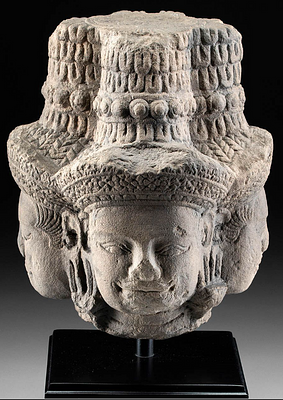Roman Marble Relief Stele of Hero w/ Widow & Child
Lot 43c
About Seller
Artemis Fine Arts
686 S Taylor Ave, Ste 106
Louisville, CO 80027
United States
Selling antiquities, ancient and ethnographic art online since 1993, Artemis Gallery specializes in Classical Antiquities (Egyptian, Greek, Roman, Near Eastern), Asian, Pre-Columbian, African / Tribal / Oceanographic art. Our extensive inventory includes pottery, stone, metal, wood, glass and textil...Read more
Categories
Estimate:
$8,000 - $12,000
Absentee vs Live bid
Two ways to bid:
- Leave a max absentee bid and the platform will bid on your behalf up to your maximum bid during the live auction.
- Bid live during the auction and your bids will be submitted real-time to the auctioneer.
Bid Increments
| Price | Bid Increment |
|---|---|
| $0 | $25 |
| $300 | $50 |
| $1,000 | $100 |
| $2,000 | $250 |
| $5,000 | $500 |
| $10,000 | $1,000 |
| $20,000 | $2,500 |
| $50,000 | $5,000 |
| $100,000 | $10,000 |
| $200,000 | $20,000 |
About Auction
By Artemis Fine Arts
Jun 29, 2023
Set Reminder
2023-06-29 10:00:00
2023-06-29 10:00:00
America/New_York
Bidsquare
Bidsquare : Exceptional Antiquities, Ethnographic and Fine Art
https://www.bidsquare.com/auctions/artemis-gallery/exceptional-antiquities-ethnographic-and-fine-art-13031
Artemis Fine Arts info@artemisfinearts.com
Artemis Fine Arts info@artemisfinearts.com
- Lot Description
Roman, Imperial Period, ca. 1st to 3rd century CE. A splendid and quite sizable marble stele hand-carved with the relief image of 3 figures with a serpent entwined around a tree. Likely representing a family, the figures are all dressed in traditional clothing: the father stands to the left tightly wrapped in a toga, the seated mother wears a stola with a palla draped over her head, and the petite child is clothed in robes resembling a peplos. Both the mother and child are shown in profile, angled toward the forward-facing male and thus directing the viewer's attention to him. The reasoning for this lies in the snake wrapping around the tree beside him: snake and tree motifs are often found in hero reliefs and are believed to function as chthonic symbol, thus suggesting the male figure to have been a deceased hero and this stele to represent him bidding farewell to his child and widow as he leaves for the afterlife. Size: 3.8" L x 22.6" W x 28.9" H (9.7 cm x 57.4 cm x 73.4 cm)
This idea is strengthened by the poses of the woman and child: the mother places one hand on her face - the most popular gesture of mourning in Classical steles - while the child holds a situla - a vessel commonly used in funerary rituals. The raised top periphery and lower area likely previously held inscriptions dedicating the stele to the deceased.
The significance of serpent-entwined trees in hero relief is debated amongst academics. Some believe that the snake represents the dead man's soul, while others have speculated that it is an attribute of a god such as Asklepios or a chthonic deity or deities, or a status symbol. The tree has been taken by some scholars to be the tree of life, a symbol of rebirth or nature, or a sacred tree.
Prior to the 2nd century, Romans cremated their dead; around that time, inspired by the Greek and Etruscan practice of using sarcophagi, they began to place their dead in sarcophagi. This trend spread rapidly throughout the Roman Empire. In the western part of the Empire, sarcophagi were placed inside a mausoleum against a wall or in a niche, so the only decorated panels were on the front and the short sides. This stele probably came from the grave of a high-status Roman citizen.
Provenance: East Coast collection, New York Gallery, New York City, New York, USA, acquired before 2010
All items legal to buy/sell under U.S. Statute covering cultural patrimony Code 2600, CHAPTER 14, and are guaranteed to be as described or your money back.
A Certificate of Authenticity will accompany all winning bids.
We ship worldwide and handle all shipping in-house for your convenience.
#177233Fragment of a larger stele. Professionally repaired from a few large pieces with some restoration over break line. Chipping with some losses to peripheries and some raised areas, such as arm of female and head of child. Expected nicks, chips, and abrasions as shown. Otherwise, the overall decorative program is very clear with liberal remaining details. Earthen deposits throughout.Condition
- Shipping Info
-
All shipping is handled in-house for your convenience. Your invoice from Artemis Gallery will include shipping calculation instructions. If in doubt, please inquire BEFORE bidding for estimated shipping costs for individual items.
-
- Buyer's Premium



 EUR
EUR CAD
CAD AUD
AUD GBP
GBP MXN
MXN HKD
HKD CNY
CNY MYR
MYR SEK
SEK SGD
SGD CHF
CHF THB
THB














